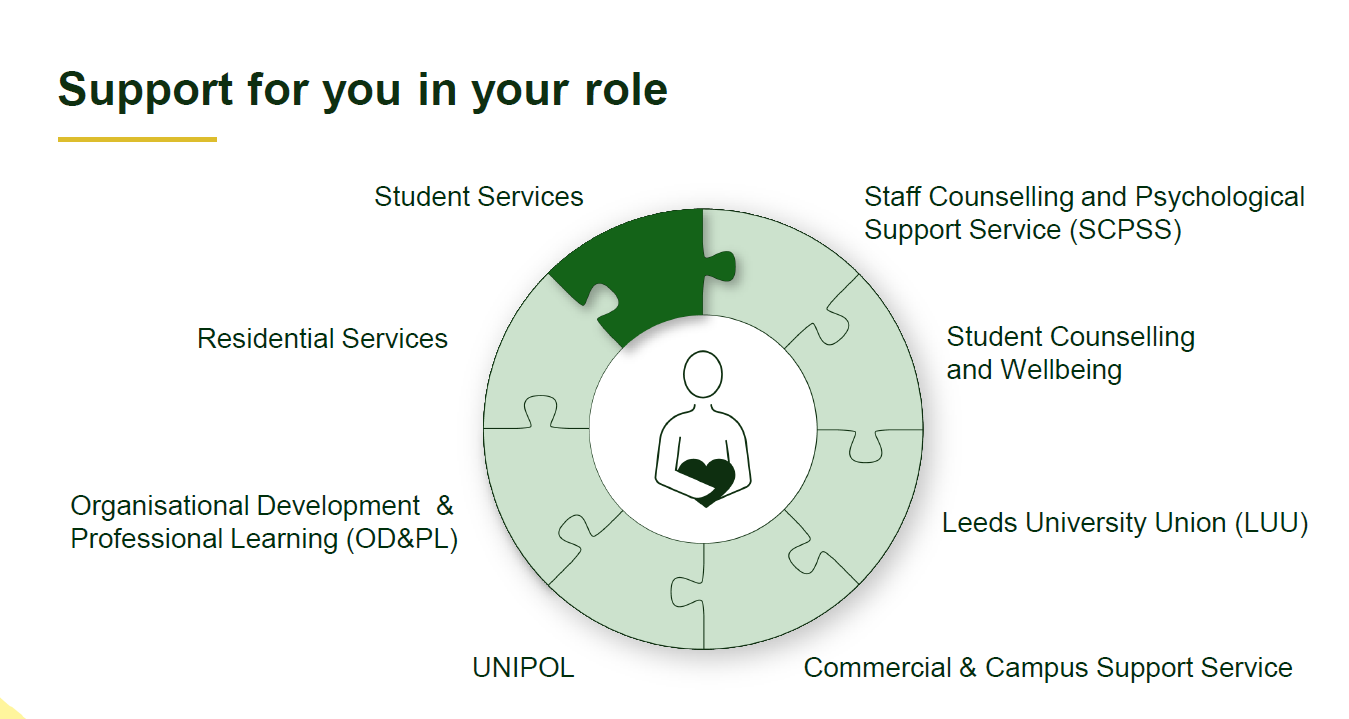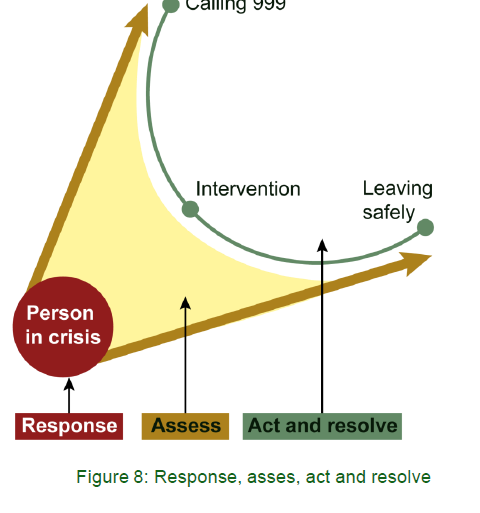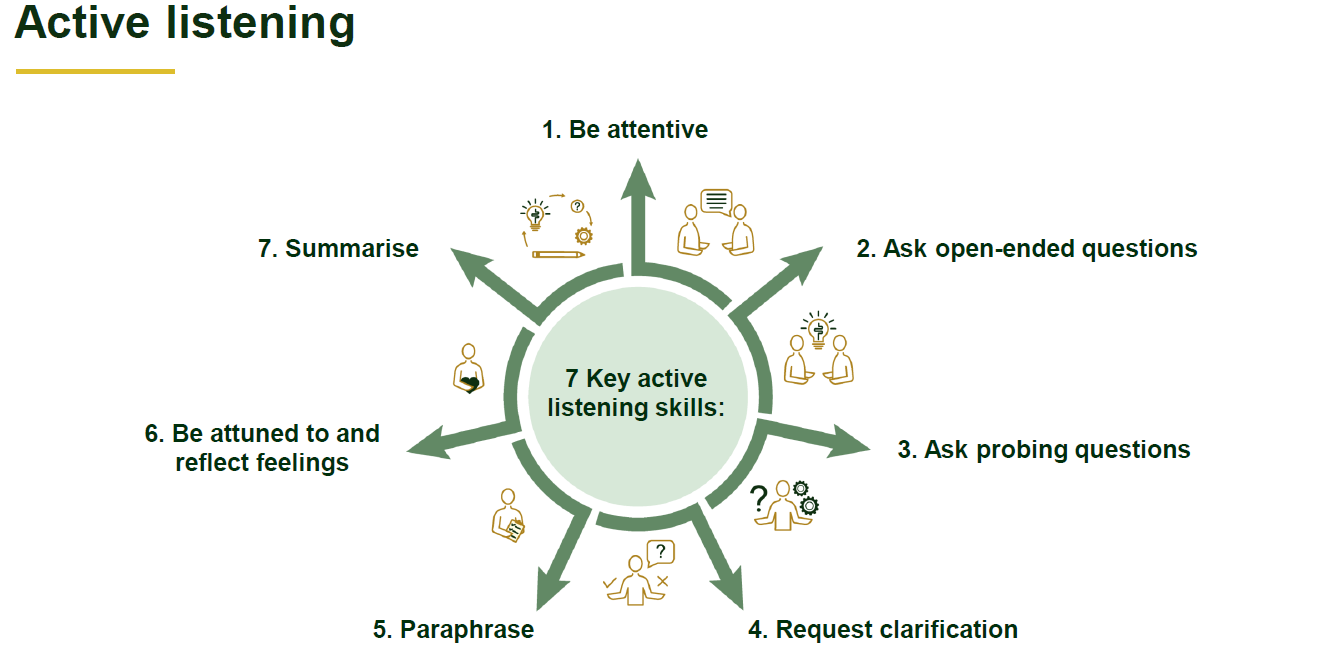Role based mental health training for frontline staff
Role Based Mental Health Training (RMBHT) brings services across campus together, creating a role-based approach to supporting students in Crisis.
It highlights how the services work together, referrals pathways, what your role in supporting students and support routes for you.
University Services, Roles, responsibilities, and limits
As a university our primary focus is Education and Research. We are a non-statutory organisation (so not fulfilling the roles of NHS, Police or Social Services). The key principles of our response in supporting students experiencing a mental health crisis are;
- To be reasonable
- To be proportionate
- To balance the needs and rights of individual students with the responsibilities of the wider organisation and university community.
We work with these principles in our Student Support Framework –
- Empowerment
- Engagement
- Integration
Approach to student safety and wellbeing: best practice
Our approach is shaped by research informed best practice recommendations in relation to supporting people who may be vulnerable or at risk, which includes:
- Adopting a student-centred approach
- The importance of collaborative working with students
- The importance of appropriate escalation to clinical staff –Student Counselling and Wellbeing and/or NHS services.
- The importance of appropriate information sharing with trusted others (with student consent and involvement). This may include family members, carers and expert professionals such as NHS staff to facilitate co-ordinated support (Triangle of Care) –to be agreed in collaboration with clinical staff –Student Counselling and Wellbeing and/or NHS services. (UUK guidance)
Support for you in your role, supporting students
Services across campus all play a unique role in helping to ensure that students access the right support at the right time. The jigsaw analogy is to show how each area of expertise comes together to provide a holistic approach to supporting students.

Student Counselling and Wellbeing (SCW)
Outline how the team respond and work with students experiencing mental health difficulties
Overview of the service offer
The service has a broad offer of support for students which includes;
- Every student who registers is offered an appointment
- Daily Wellbeing Drop-In, bookable on the day, Mon and Tues at 4 LP and Weds to Fri at LUU
- Individual Counselling, Wellbeing and Mental Health appointments (in-person & online)
- Wellbeing Webinars, Workshops and Groups Programme inc. Meditation, Mindful Relaxation
- Lifestyle and Wellbeing Programme with Sports and Physical Activity
The service also has a range of support responses which enable students to receive the appropriate support and intervention depending on the circumstances. These include;
- Priority Appointment Structure including ‘Sense Checks’ and 'Registration Follow Ups'
- Risk management –coordinated support with NHS, mandatory location details and emergency contact.
- Clinical Guidance and Support pathway, known informally as ‘Duty’
- Enhanced Support Pathway and Assertive Outreach
- 24/7 online support through Togetherall(all UoLregistered students and staff) – put link
Leeds University Union (LUU), Help and Support
Independent of the university, LUU offers a range of support and advocacy for students.
Watch the LUU Help and support video
University Security Services
The university security team work 24/7 and deal with some of the most challenging situations, especially when most services are closed for the day. Here is an overview of their approach and how they support students and work with colleagues to help students access the relevant support they need.
Helping in a crisis
Security staff can get called to a wide range of situations including distressed students when something has happened through to immediate threats to safety. This diagram offers an insight into the range of decision making that is needed in the moment.

This diagram shows that through the information the security staff have already and what they learn from talking to the student, staff have to determine where on the line a student is in the moment. Depending on what has happened the student can move along that line, becoming calmer or more agitated. Through their training and experience, staff will make a judgement call as to whether immediate help is needed, e.g. 999 or the student can be left safely and linked in with support services.
Every such situation will result in a security report being made which is then picked up by the relevant service to ensure the student receives a reach out support offer.
Your role
Listening to what is needed and using the referral pathways
The role based approach is an essential way of ensuring that you work within the boundaries and expectations of your role. This is to support you and ensure that students are receiving the right support at the right time.
The jigsaw analogy is a reminder that you are not on your own and don’t have to deal with every situation. Colleagues in these services are here to use their expertise to help support in the situations.
You have a key role in helping identify if a student needs support, gathering the essential information that will help support the right referral pathway and helping to give the student the confidence that support is there for them.
A key element of this is Communication, especially how we actively listen to what someone is telling us and ensuring that we understand what is happening. This diagram can help to give a few pointers on being there in the moment for the student, creating a space to talk and getting the appropriate information so that you know which support route will be the best option

Seven tips for active listening
- Be attentive
- Ask open-ended questions
- Ask probing questions
- Request clarification
- Paraphrase
- Be attuned to and refect feelings
- Summarise
Self care
Actively listening to someone telling you something that is emotionally challenging – can be exhausting for you. This is ok, it is normal. You may hear things that trigger an experience for you or may have an overload of students in difficult situations that can feel overwhelming. Alongside ensuring the students access the right pathways for support – it is also important that you know what you need and what can help.
Understanding your workable range
This video is a must watch, it was developed by Dr Sally Rose here at the University. Her innovative Workable Ranges Model provides a way of mapping healthy balance and forms of stress and strain in relation to each other. The model has been recognised as a significant development in stress theory.
https://mymedia.leeds.ac.uk/Mediasite/Play/a1e59f6b45824c708acd590889d196111d
Support and further training
https://ses.leeds.ac.uk/info/22260/support_and_further_training_for_you